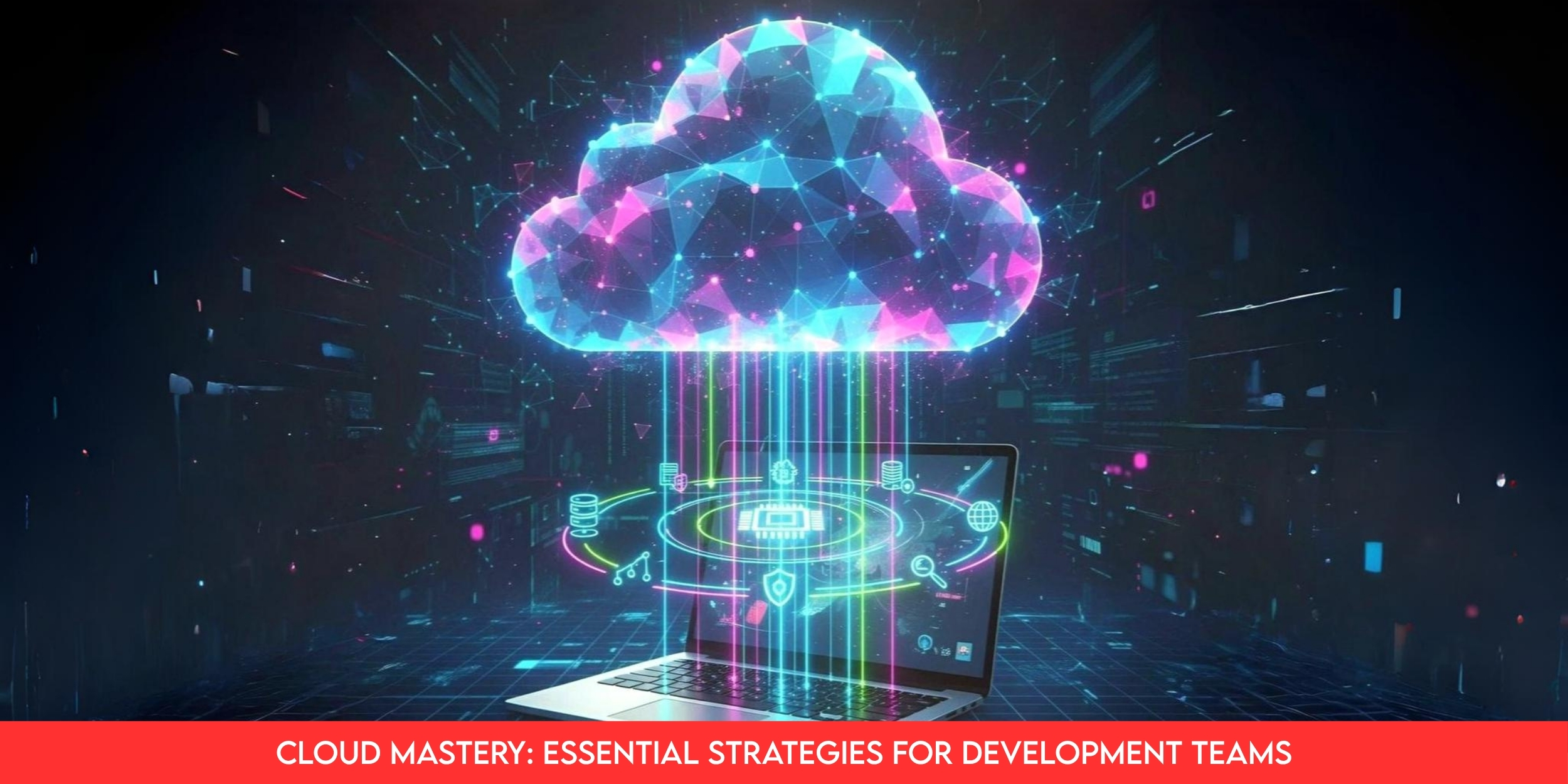
Introduction
You’re part of a development team that’s no longer just writing features. You’re now stewards of the cloud managing infrastructure, cost, performance, security and team velocity all at once. That shift from “just code” to “code + cloud operations” can feel like juggling chainsaws. Without the right coordination, your cloud becomes a cost monster, a security risk, or a drag on innovation. What you need is effective cloud management.
In this article we’ll walk you through essential strategies your team can adopt today to move from chaos to cloud mastery so you build with speed, operate with discipline, and deliver value reliably.
The Challenge for Development Teams in the Cloud Era
Development teams in 2025 face an amplified set of pressures. The expectation to deliver faster, deploy globally, support hybrid or multi-cloud platforms and do so while staying within budget and maintaining security is very real. As Google Cloud notes, managing resources across public, private, hybrid or multiload environments is hard because you must maintain visibility and control.
If your team treats the cloud as just another target environment, you’ll run into three major risks: uncontrolled cost escalation (cloud sprawl), inconsistent performance, and security or compliance failures. Effective cloud management isn’t optional, it’s foundational for any development team that wants to move fast without falling behind.
Pillar 1: Align Cloud Management to Business & Dev Goals
First move: don’t treat cloud management as a separate discipline. Your cloud practices must be directly aligned with your business and development goals. That means asking: What outcomes does the business expect? Are we targeting faster time-to-market, lower cost per release, global scaling, better uptime? Your cloud strategy should live within the roadmap your dev teams and product owners use.
According to research on cloud strategy, one of the key components is business alignment: define goals, pick deployment models (public/hybrid/multi-cloud) and establish governance to tie back to those goals.
For your dev team that means: include cloud-related metrics (e.g., deployment frequency, mean time to recover, cost per instance) as part of your sprint goals. If you don’t make cloud infrastructure part of the development lifecycle, you’ll end up with “infrastructure lag” where dev delivers code but the environment drags behind.
Action step: Within your next sprint planning, include one cloud-management metric (e.g., % of idle resources cleaned up, deployment automation coverage) and commit to it as part of your Definition of Done.
Pillar 2: Governance, Visibility & Control
Once you’re aligned, you need governance. That means you must know what resources exist, who uses them, how they’re configured and you must apply controls. The biggest cloud management pitfall is “cloud sprawl”: unchecked provisioning, many small forgotten services, cost leakage.
Your development team should adopt:
tagging policy (every resource must be tagged with owner, project, cost center)
central dashboard for resource usage, cost and performance
approval workflows for new provisioning (even if it’s self-service)
regular reviews (what’s idle? what’s under-utilized?)
In doing so, you turn cloud management from reactive firefighting into proactive stewardship.
For dev teams this means: when you spin up a new service or environment, you must follow tagging and provisioning guidelines rather than “just create and worry later.”
Action step: Define a minimal “cloud resource template” that your team must follow (tags + budget + owner + expiration date). Audit last week: list all resources older than 90 days with no tag and clean them up.
Pillar 3: Automation, DevOps & Lifecycle Management
Your development team is used to automation CI/CD, automated testing, deployments. Apply the same mindset to your cloud infrastructure. Effective cloud management relies on automation of provisioning, scale-up/down, configuration and retirement. According to a guide on cloud management, automation is one of the core features enabling performance monitoring, cost control and governance.
For dev teams this means: use infrastructure-as-code (IaC) to declare environments; integrate provisioning into pipeline; schedule teardown of environments when not needed; automate rightsizing alerts.
When you automate cloud tasks, you not only reduce human error but also free your team to focus on delivering value rather than babysitting infrastructure.
Action step: Pick one non-production environment this sprint and convert its provisioning to IaC + include automatic teardown or scale-down when idle. Track time saved in next sprint retrospective.
Pillar 4: Cost Optimization & Efficiency
Here’s the part your finance team cares about and your dev lead might overlook. Without cost optimization, cloud management becomes expensive. The good news: cost optimization is part of discipline and automation.
According to an expert guide, effective cloud management identifies unused, idle or under-utilized resources and rightsized accordingly.
For dev teams, that means:
schedule non-critical services to shut down after hours
use lower-cost instance types for dev/test environments
consider spot or reserved instances where feasible
allocate cloud budget per team and make cost visible
When you make cost a shared responsibility with dev, you shift from “someone else’s budget” to “we own it.” That cultural shift is powerful.
Action step: In your next review, present a cost-report for the last release: list top 3 cloud resources by spend, ask: “Can we switch them to cheaper alternatives or turn them off when idle?”
Pillar 5: Security, Compliance & Risk Management
Cloud development teams often push features fast. That’s great but if your cloud management strategy doesn’t address security and compliance, you’re building risk. According to the definition of cloud management, securing data, controlling access and ensuring compliance are core responsibilities.
For your team:
adopt “security as code”: automate identity & access controls, encryption, logging
integrate security checks into pipeline (e.g., cloud resource config scanning)
establish incident response for your cloud workloads
monitor across multiple clouds if you’re using a multi-cloud or hybrid model
Your dev team is part of the frontline for risk. When you bake in security and compliance into your cloud management routines, you reduce fire drills and build trust.
Action step: Schedule a “cloud security review” each sprint: identify one environment, run a configuration-scan for compliance, log findings, fix top 2 issues.
Bringing It All Together: Building a High-Performing Cloud Dev Team
Strategy is fine, but execution depends on team culture and capabilities. Your best cloud management plan will fail if the team sees it as “extra work.” So:
Train your dev team not just in code but in cloud operations.
Celebrate its wins: e.g., “we reduced cost by 15% this release thanks to rightsizing” or “we auto-provisioned staging in 5 minutes this sprint.”
Use metrics: deployment frequency, mean time to recover, cost per release, % of resources tagged/compliant.
Encourage continuous improvement: review last sprint’s cloud-management metric and iterate.
When you treat cloud management as part of your development delivery fabric (not a separate silo), you’ll achieve mastery not just usage.
Case Snapshot
Imagine a SaaS company whose dev team had grown quickly and deployed frequently but their cloud costs ballooned, performance was inconsistent across regions, and the security audit flagged “orphaned services” and “unmonitored resources.” They implemented the five strategies above: aligned cloud goals with product roadmap, enforced tagging/approval, automated provisioning with IaC, introduced cost-review rituals every sprint, and built security checks into the pipeline. Within three months they cut cloud spend by 22%, reduced deployment lead-time by 30 % and passed external audit with zero critical findings. That’s cloud management done right.
FAQs
Q: What is cloud management and why does my dev team need it?
Cloud management is the oversight, control and administration of cloud computing resources, services, and infrastructure whether public, private, hybrid or multi-cloud environments. Your dev team needs it because as you move faster into the cloud, you risk cost overruns, performance issues and security gaps if you don’t manage the environment deliberately.
Q: How do we decide which cloud workloads to include in our management plan?
Start with the ones you deploy most frequently or cost most. Use business alignment: focus on workloads tied to product value or cost. Then apply your governance, automation and optimization practices. A roadmap helps rather than trying everything at once.
Q: Can development teams implement these strategies, or do we need a separate cloud ops team?
Yes, it’s best if dev teams own the cloud management practices. That said, you may still need specialists for deep infrastructure or security tasks. The key is integrating cloud-management practices into the dev workflow rather than leaving it to a separate silo.
Q: How many resources should we automate before we call ourselves “good”?
There’s no magic number. But if your dev team has automated provisioning, teardown of idle resources, tagging enforcement, and integrates cost/visibility dashboards into sprint reviews, you’re in strong shape. The goal is continuous improvement, not 100 % automation on day one.
Q: What metrics should we track to know our cloud management is working?
Track things like: percentage of resources tagged and compliant; cost per deployment or per environment; number of idle or under-utilized resources freed; deployment lead time; mean time to recovery; security audit findings. These give you clarity on performance, cost and risk.
Conclusion
You and your development team have already built software. Now you’re building in the cloud. That shift makes cloud management no longer optional it is your backbone. By aligning cloud practices with business and dev goals, establishing governance and visibility, automating lifecycle often, optimizing costs and embedding security into everything, you’ll turn cloud from a headache into a strategic advantage.
Start by choosing one metric this sprint (tagging coverage, cost saved, automated teardown) and commit to it. The rest will follow. Cloud mastery isn’t a destination it’s your next sprint’s goal.




